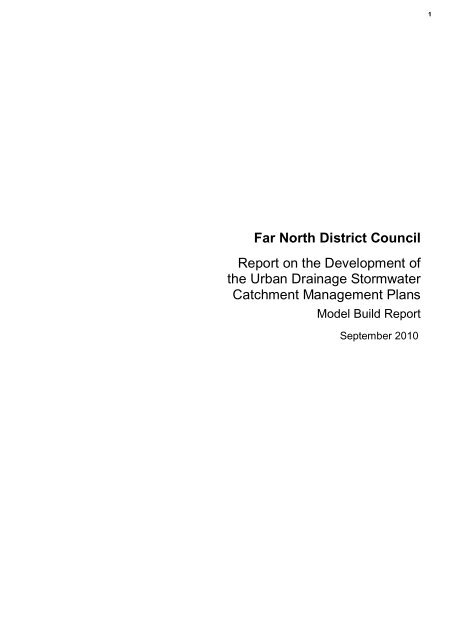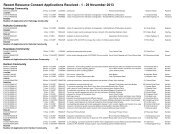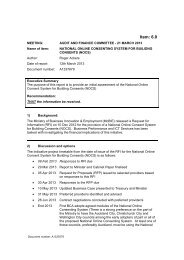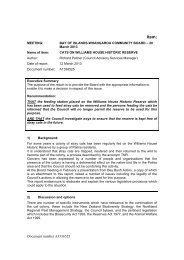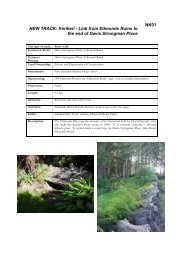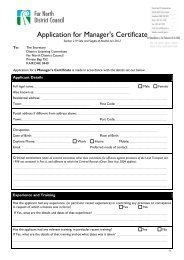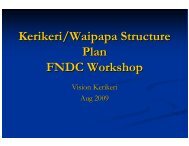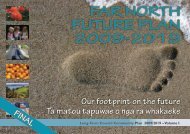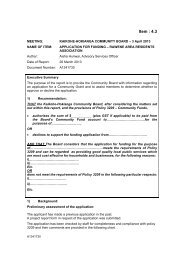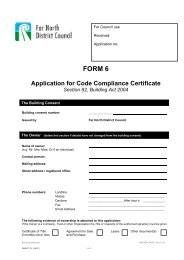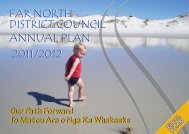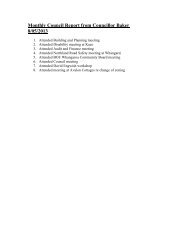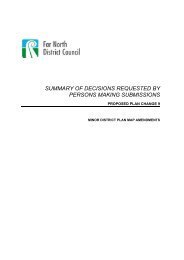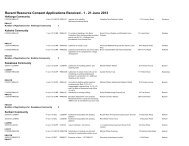FNDC Stormwater - Far North District Council
FNDC Stormwater - Far North District Council
FNDC Stormwater - Far North District Council
You also want an ePaper? Increase the reach of your titles
YUMPU automatically turns print PDFs into web optimized ePapers that Google loves.
1<strong>Far</strong> <strong>North</strong> <strong>District</strong> <strong>Council</strong>Report on the Development ofthe Urban Drainage <strong>Stormwater</strong>Catchment Management PlansModel Build ReportSeptember 2010
2Contents1. Introduction and Overview 11.1 Objectives 11.2 Activities and Scope 12. Study Area 22.1 Location 22.2 Characteristics of the Study Area 23. Model Build Details 33.1 Overview of Model 33.2 Receiving Environment 53.3 Model Assumptions 63.4 Hydrologic Model 93.5 Hydraulic Model 133.6 Boundary Data 143.7 Model Runtime Information 143.8 Quality Assurance and Quality Checks (QA/QC) 144. Calibration/Validation 154.1 Overview 154.2 Monitoring Data 154.3 Calibration/Validation Process 155. Flood Plain Mapping 165.1 Flood Plains in a 1-D Model 165.2 Flood Plains in a 2-D Model 165.3 Interpretation of Flood Plain 166. Peer Review/<strong>Council</strong> Queries 177. Conclusions 18Table IndexTable 1 Software Used 3Table 2 Modules used in the Model 3Table 3 File Designations for the Modelled Scenario 451/28881//ModelBuild_vcreview_CMAReview.doc<strong>Stormwater</strong> Catchment Management PlansModel Build Report
3Table 4Table 5Table 6Table 7Summary of Model Components for variousSWCMP Catchments 4List of SWCMP Catchments and their ReceivingEnvironments 5Catchment Design Rainfalls for Various ARI StormEvents 10Distribution of 24-hour Total Rainfall over certainDuration 12Figure IndexFigure 1 Location of SWCMP’s in <strong>FNDC</strong> under this Study 2AppendicesAPeer Review/<strong>Council</strong> Queries51/28881//ModelBuild_vcreview_CMAReview.doc<strong>Stormwater</strong> Catchment Management PlansModel Build Report
41. Introduction and OverviewGHD was commissioned by <strong>Far</strong> <strong>North</strong> <strong>District</strong> <strong>Council</strong> (<strong>FNDC</strong>/<strong>Council</strong>) to produce the <strong>Stormwater</strong>Catchment Management Plans (SWCMP’s) for the numerous Urban Catchments throughout the <strong>FNDC</strong>jurisdiction.This report provides details on the processes used to develop the hydraulic and hydrological models thatunderpin the SWCMP’s and serves as a Model Build report.1.1 ObjectivesThe objective of this report is to provide a detailed description of the processes used through thedevelopment of the computer modelling studies that contribute to the development of the SWCMP’s1.2 Activities and ScopeThe following activities were undertaken during the development of the models for all the SWCMP’s:1.2.1 Review of Existing ReportsExisting SWCMP reports and other related documents were received from <strong>Council</strong> and reviewed forrelevance to the model build process.1.2.2 Model Build PhaseAcquire stormwater asset data (type, location, elevation, connectivity and dimensions) from<strong>Council</strong>;Obtain topographical data, LiDAR, from the joint <strong>FNDC</strong>/NRC data capture exercise;Sub-catchment Delineation;Hydrological Model Development;Network Set-Up for the existing situation;Catchment Data Set-Up for the existing situation;Boundary Data Resolution; andCatchment Data Set-Up for the future situation.1.2.3 Calibration and Validation PhaseCalibration of the models was undertaken for Kaeo and Kerikeri Catchments; andValidation of models was undertaken for Kaeo and Kerikeri Catchments.1.2.4 Model OutputsThe peak flood levels and flows were extracted from the model and are provided in the appendices of theSWCMP report.51/28881//<strong>Stormwater</strong> Catchment Management PlansModelBuild_vcreview_CMModel Build ReportAReview.doc1
52. Study Area2.1 Location23 SWCMP’s were prepared. The locations of the catchments are shown in Figure 1 below:Figure 1Location of SWCMP’s in <strong>FNDC</strong> under this Study2.2 Characteristics of the Study AreaThe characteristics of each SWCMP Catchment were determined based on the following:Topography;Land use;Underlying Geology;Inlets and Outlets;Major streams within the catchment;Extent of pipe network;Water quality at the outfall; and,Problem areas in the catchment.51/28881//<strong>Stormwater</strong> Catchment Management PlansModelBuild_vcreview_CMModel Build ReportAReview.doc2
63. Model Build Details3.1 Overview of Model3.1.1 Model TypeThe model simulates the integrated hydrological and hydraulic system for flow for the catchment area ofeach SWCMP. The methods used in the model are in accordance with GHD modelling practices andpractices used in the water industry in New Zealand and around the globe.3.1.2 SoftwareThe following software was used to model the Urban Drainage Catchments within the <strong>FNDC</strong> jurisdictionare shown in Table 1.Table 1Software UsedCatchment Software Software VersionAll catchments, excepting Kerikeri and Kaeo MOUSE Version 2008 & 2009KerikeriMIKE URBAN / MIKE11Version 2009Kaeo MIKE 11 and MIKE 21 Version 2009MOUSE is an advanced, powerful and comprehensive program for modelling of urban drainage systemsincluding surface water runoff, open channel flow, pipe flow, water quality and sediment transport forstormwater and sanitary sewers applications, developed by the Danish Hydraulics Institute (DHI), wasused for pipe and overland conveyance assessment.MIKE 11 is an advanced, powerful and comprehensive program for modelling of surface runoff, openchannel, water quality and sediment transport package. The MIKE 11 model was used for modelling theriver systems in Kerikeri and Kaeo Catchments.Two models were used to model the catchment and generate the floodplain maps for the Kaeocatchment. The river model (MIKE 11) models the flows in the river system. The terrain model (MIKE21) receives flows from the river system as soon as flood levels exceed the bank level and simulatesflows in the floodplain. MIKE FLOOD has been used as interface to combine these models so that theflows between the river model and the Terrain model are managed by MIKE FLOOD.3.1.3 Modules UsedThe following modules as shown in Table 2 were used in the model: -Table 2Modules used in the ModelModule NameMOUSE RRDescriptionUsed to estimate catchment runoff51/28881//<strong>Stormwater</strong> Catchment Management PlansModelBuild_vcreview_CMModel Build ReportAReview.doc3
7Module NameMOUSE Model BMIKE 11 Model BMOUSE HDMIKE 11 HDDescriptionAn advanced tool to estimate catchment runoffAn advanced tool for estimating catchment runoffUsed for hydraulic analysis of channel/pile flowsUsed for hydraulic analysis of channel flows3.1.4 File UsedThree land use scenarios were used for developing models for all the SWCMP Catchments, namely: -Existing Development (ED);Maximum Probable Development (MPD); andMaximum Probable Development with Climate Change allowances (MPD+CC).Each land use scenario was analysed for the 5, 10 and 100-year ARI rainfall events. The File Namesare generally preceded with the name of the catchment. The file naming system as an example for thesimulation of 5 year ARI rainfall event for the Houhora/Pukenui Catchment is shown in Table 3 below.Table 3File Designations for the Modelled ScenarioFile Name File Type File DescriptionHouhoraPukenui_5ED .MPR Simulation File for 5-year EDHouhoraPukenui_5ED .UND Network File for 5-year EDHouhoraPukenui_5ED .HGF Hydrological File for 5-year EDHouhoraPukenui_5ED .CRF Catchment Output Flow File for 5-year EDHouhoraPukenui_5ED .PRF Network Output File for 5-year ED3.1.5 Summary of Model AttributesA summary of the main components in the model for each SWCMP are summarised in Table 4 below:Table 4Summary of Model Components for various SWCMP CatchmentsCatchment Name Sub-catchments Nodes LinksAhipara 127 519 425Awanui 95 358 318Doubtless Bay 389 2,275 1,916Haruru Falls 236 633 549Houhora/Pukenui 111 355 290Kaikohe 153 764 72551/28881//<strong>Stormwater</strong> Catchment Management PlansModelBuild_vcreview_CMModel Build ReportAReview.doc4
8Catchment Name Sub-catchments Nodes LinksKaitaia 540 2,812 2,550Kerikeri (MOUSE only) 429 1872 1714Kawakawa/Moerewa 342 1,169 993Kohukohu/Rawene 108 334 249Okiato 53 168 125Russell Centre 126 547 457Tapeka Point 28 47 33Opua/Veronica 138 523 429Omapere/Opononi 135 605 511Paihia/Te Haumi 410 1,417 1,246Rangiputa 33 100 79Whatuwhiwhi 192 639 567Whangaroa 103 274 208Kaeo N/A N/A N/AThe Kaeo catchment has very few stormwater pipe assets and these are mostly road crossing culverts.These assets have been included in the MIKE 11 model as culverts and the SWCMP catchment areawas incorporated into the Kaeo River Catchment in MIKE FLOOD model, (i.e. MIKE 11 and MIKE 21).It should be noted that Kohukohu and Rawene are two separate SWCMP’s, however because of theirclose proximity to each other one single model has been developed, although the assets and subcatchmentshave unique names to separate them according to their respective catchment.3.2 Receiving Environment3.2.1 Receiving EnvironmentThe receiving environments of the SWCMP catchments are either inland rivers or sea and are indicatedin Table 5.Table 5List of SWCMP Catchments and their Receiving EnvironmentsCatchment NameAhiparaAwanuiDoubtless BayType of Receiving EnvironmentCoastalRiverCoastal51/28881//<strong>Stormwater</strong> Catchment Management PlansModelBuild_vcreview_CMModel Build ReportAReview.doc5
9Catchment NameHaruru FallsHouhora/PukenuiKaikoheKaitaiaKerikeriKawakawa/MoerewaKohukohu/RaweneOkiatoRussell CentreTapeka PointOpua/VeronicaOmapere/OpononiPaihia/Te HaumiRangiputaWhatuwhiwhiWhangaroaKaeoType of Receiving EnvironmentRiverCoastalRiverRiverCoastalRiverCoastalCoastalCoastalCoastalCoastalCoastalCoastalCoastalCoastalCoastalRiverThe boundary data for each SWCMP can be found either in both the SWCMP report or in the model.3.3 Model AssumptionsAssumptions were made during the modelling process in order to appropriately represent the flow andlevel situation. The models are also subject to limitations that need to be considered when interpretingresults or re-running the model for a purpose other than Flood Hazard Mapping. The assumptions madeare described in the following sections: -3.3.1 Hydrological Model AssumptionsThe condition applied to the hydrology in MOUSE is wet soil, (i.e. it has very limited infiltration andstorage), as defined in the Regional Approach to Hydrological Modelling, (Metrowater, 2004).Different antecedent condition could result in a different extent of flooding;House rainwater tanks, if any, are assumed to be full at the start of any simulated event – i.e. roofrunoff is directly connected to the overland flow elements of the model;No formal soakage is included in the model;51/28881//<strong>Stormwater</strong> Catchment Management PlansModelBuild_vcreview_CMModel Build ReportAReview.doc6
10For the ED scenario, the impervious percentages are determined by using available aerialphotographs. Sample areas were chosen based on density of development and were applied toother areas with similar development density. The road reserve is assumed to be developed to80% imperviousness;For the MPD scenario the impervious percentages are determined according to the maximumimpervious percentage for each zone as defined in the <strong>District</strong> Plan, with the road reserveassumed to be developed to 80% imperviousness;Where the existing imperviousness already exceeds the permitted imperviousness, the existingimperviousness was used in the MPD scenario;<strong>Stormwater</strong> sub-area boundaries follow property boundary lines in urbanised areas as much aspossible;<strong>Stormwater</strong> sub-area slopes were calculated from topographical information, (i.e. LiDARcontours). An average slope method, (i.e. change in elevation from highest point in the sub-areato lower point over length of flow path), using the Equal Area Method was used in the model;The impervious ratio between impervious directly connected (i.e. Model B) and imperviousunconnected is assumed as follows: -Road impervious surfaces are directly connected and the other impervious surfaces, (i.e.roofs and driveways), are unconnected;Road runoff directly flows to the roadside drains and is then transported to the streams,whereas other runoff infiltrates or generates slow overland flow;The effects of Climate Change on the hydrology have been taken into account by using ClimateChange effects, as defined in the Ministry for the Environment (MfE) 2006 Guidelines, for whichthe main criteria are: - A temperature rise in the range of 0.6 - 3.8°C is likely during the period 1990 – 2080;A 24-hour 100-year ARI rainfall event is predicted to be a 6.7% increase in intensity per1°C; and A lift in the tidal boundary of MHWS + 0.2 m. For the modelling of Climate Change a 3°C temperature rise was considered, which equates to: -A 20.1% increase in the 100-year ARI HIRDS 24-hour intensity.No constant natural base flow has been added in the stormwater system.The linkage between the hydrological model and the hydraulic model is done through individualsource points. For each sub-catchment a runoff hydrograph is generated in the hydrologicalmodel and applied as a source point in the hydraulic model.3.3.2 Hydraulic Model AssumptionsNo blockage has been assumed in manholes, pipes, culverts and entry points to the stormwatersystem;<strong>Stormwater</strong> asset elements are assumed to be in good condition and no sedimentation has beenassumed in the stormwater pipelines, (i.e. all pipes and culverts are capable of performing at fullcapacity during the validation events);51/28881//<strong>Stormwater</strong> Catchment Management PlansModelBuild_vcreview_CMModel Build ReportAReview.doc7
11<strong>Stormwater</strong> can freely exit the network, (i.e. outlets are not blocked);No sedimentation or erosion of watercourses and overland flow paths either during storm events,or gradually over time, has been allowed for in the modelling;Change in asset condition over time is not modelled;The hydrological source points have been placed either at the modelled manhole or at a overlandflowpath node in the absence of stormwater manhole;In the model development phase, LiDAR point elevation data supplied by <strong>Council</strong> was used to setup the model geometry and in the floodplain mapping phase to evaluate the floodplain. TheLiDAR Digital Terrain Model (DTM) is stated to have an accuracy of about ± 0.25 m with a 95%confidence interval (ALGGi, 2007). Therefore the computed flood levels are at best only accurateto within ± 0.25 m (at 95% confidence) excluding other possible cumulative errors, which may bepresent, such as those resulting from other assumptions indicated in this section of the report; andIsolated small driveway culverts within the drainage system have not been included in the model.3.3.3 Boundary Conditions AssumptionsThe design rainfalls have been derived from the HIRDS model based on NIWA rainfall recordsthat allows point rainfalls to be estimated for any latitude and longitude around New Zealand.The temporal rainfall pattern is based on the assumption that 50% of the rainfall event willcoincide with half of the storm duration. The distribution of rainfall has been adopted as there isno analysis available on the temporal distribution of rainfall events in <strong>North</strong>land. The use of 24-hour storm duration is an accepted convention that allows the effects of all intensities anddurations to be incorporated into an assessment of catchments that have varying times ofconcentration.Tide levels are assumed to be constant during the design storm model runs. The downstreamtidal boundary condition for floodplain mapping is Mean High Water Springs (MWHS) at the levelsrelative to One Tree Point (OTP). For the climate change scenario a constant tidal boundary ofMHWS + 0.20 m was used. The MWHS at the outfall of each SWCMP was derived from theNIWA website and the value can be found in the SWCMP report;Storm surge was not considered in the model tidal boundary; and3.3.4 LimitationsThe model represents the current situation at the time of the study. No account has been taken ofthe execution of any later construction, operations or maintenance work that may affect systemperformance (e.g. stream cleaning, new stormwater network, etc.);No blockage has been assumed in the modelled manholes, pipes, culverts and entry points intothe stormwater system;Numerous small drains have not been represented in detail in the model. These drains are toosmall to have a significant role during a major flood event, (i.e. 5, 10 and 100-year ARI rainfallevents), as their capacities would be quickly exceeded. The impact of these drains is beyond thelevel of accuracy of catchment-wide floodplain mapping. For more detailed analysis these drainsshould to be modelled after further data collection;51/28881//<strong>Stormwater</strong> Catchment Management PlansModelBuild_vcreview_CMModel Build ReportAReview.doc8
12The model represents the flood risk for the 5, 10 and 100-year ARI rainfall events. The modelmay not be applicable for representing lower return period events without modification; andThe model is valid for the prediction of flood hazards within the model extent at a catchment scale.Minor or localised flood risks may exist outside the model extent.3.4 Hydrologic Model3.4.1 Method UsedThe MOUSE/MIKE 11 hydrological model was used to determine stormwater runoff. The KinematicWave equations (Model B) and Unit Hydrograph Method (UHM) Modules were used to estimate runofffrom the catchment. For further information regarding the runoff method and modules used, includingdetails of runoff calculations visit: -http://www.dhigroup.com/The MOUSE hydrological model was not coupled dynamically with MOUSE hydraulic model. TheMOUSE hydrological model was run independently and the results imported as source points into theMOUSE hydraulic model. As there is no possibility of the hydraulic model affecting the hydrology, this isan entirely one-way process – no further iteration or interaction between the MOUSE hydrology andhydraulic elements is necessary.3.4.2 Sub-catchmentsEach SWCMP area was broken up into small sub-catchments. Table 4 in Section 3.1.5 summarises thenumber of these sub-catchments and the Appendices in the SWCMP report provide their sizes. Thelocation of these sub-catchment boundaries for the SWCMP catchment can be seen in the Map Book.3.4.3 <strong>Stormwater</strong> Hydrological Characteristics<strong>Stormwater</strong> sub-catchment definition used a combination of GIS data, field inspection and anecdotalevidence from landowners gathered during field inspections. The slope for each of the stormwater subsubcatchmentwas determined using equal area method using drop in elevation, computed along thelongest overland flow path.3.4.3.1 Model B ParametersWithin the MOUSE software it is possible to define the different hydrological parameter sets for the runofftype Model B. A parameter set is identified by a string of up to 13 characteristics that describes Wetting,Storage, Infiltration and the Surface Roughness of the catchment. The parameters were selecteddepending on the physical characteristics of the sub–catchment such as average slope, flow path length,vegetation coverage, type of underlying geological feature, etc.3.4.3.2 UHM ParametersThe parameters within the MOUSE UHM module were determined based on proportion of pervious andimpervious area; sub-catchment slope and length; geology of the subcatchment; and vegetationcoverage.51/28881//<strong>Stormwater</strong> Catchment Management PlansModelBuild_vcreview_CMModel Build ReportAReview.doc9
133.4.3.3 Scenario DevelopmentWithin the MOUSE model, the hydrological conditions for both the ED and MPD scenarios have beenrepresented.ED pervious and impervious ratios for the each sub-catchment were obtained from an aerial photo studycarried out as stated earlier.The limits for the MPD imperviousness allowance for various land use categories were based upon the<strong>Council</strong>’s <strong>District</strong> Plan allowances.The proportion of pervious and impervious areas for each sub-catchment of an Urban Catchment isprovided in the SWCMP report.3.4.3.4 Connection to Hydraulic ModelThe linkage between the hydrological model and the hydraulic model is done through individual “sourcepoints”. For each sub-catchment the runoff hydrograph calculated by MOUSE was applied as sourcepoints in the hydraulic model.3.4.4 RainfallsAs stated earlier that the design rainfall for each catchment for the flood plain mapping was extractedfrom NIWA HIRDS Version 2. The 24-hour total point rainfalls for various ARI storm events along withthe co-ordinates of the point rainfall for each Urban Catchment are listed in the table below:Table 6Catchment Design Rainfalls for Various ARI Storm EventsCatchmentCo-ordinates (NZMG)24-Hour Rainfall (mm) for VariousARIEasting <strong>North</strong>ing 5-year 10-year 100-yearAhipara 2,524,127.1 6,669,852.8 99.1 115.1 181.4Awanui 2,534,567.0 6,683,226.0 104.0 120.4 189.2Doubtless Bay (CBE) 2,558,349.0 6,689,699.7 109.4 126.4 198.2Doubtless Bay (CBW) 2,556,916.4 6,689,540.7 105.6 122.1 191.7Doubtless Bay (Mangonui) 2,559,211.1 6,689,536.5 113.6 131.3 205.7Doubtless Bay (Taipa) 2,554,520.6 6,689,612.9 104.3 120.6 189.3Haruru Falls 2,606,050.6 6,656,535.6 123.1 143.8 230.8Houhora/Pukenui 2,521,627.3 6,709,943.5 97.9 113.2 179.8Kaikohe 2,582,772.1 6,644,104.9 142.6 166.7 268.6Kaitaia 2,534,892.9 6,676,947.7 103.25 119.6 187.7Kerikeri (S1) 2,596,823.9 6,663,861.3 135.7 158.2 253.9Kerikeri (S2) 2,590,862.2 6,666,155.8 148.7 173.4 278.851/28881//<strong>Stormwater</strong> Catchment Management PlansModelBuild_vcreview_CMModel Build ReportAReview.doc10
14Co-ordinates (NZMG)24-Hour Rainfall (mm) for VariousARIKerikeri (S3) 2,586,549.7 6,665,457.1 157.7 183.9 295.9Kerikeri (S4) 2,590,587.9 6,663,177.5 150.1 175.1 282.2Kerikeri (S5) 2,587,888.0 6,660,549.9 163.15 190.3 306.7Kerikeri (S6) 2,594,235.7 6,662,437.9 143.9 167.8 269.8Kerikeri (S7) 2,583,928.3 6,662,702.0 163.65 190.9 307.7Kerikeri (S8) 2,597,004.5 6,661,167.4 137.35 160.2 257.4Kerikeri (S9) 2,598,907.8 6,664,220.6 132.5 154.5 247.7Kerikeri (S10) 2,596,716.9 6,666,423.2 133.5 155.6 249.5Kawakawa/Moerewa 2,607,815.0 6,645,785.0 119.6 139.9 225.6Kohukohu 2,559,956.0 6,648,997.1 101.0 117.5 187.2Rawene 2,556,596.6 6,644,140.1 91.4 106.4 169.5Okiato 2,612,725.8 6,654,584.9 119.4 143.0 229.1Russell Centre 2,613,304.6 6,659,372.1 119.1 142.5 227.5Tapeka Point 2,612,844.7 6,660,625.0 119.3 142.7 227.9Opua/Veronica 2,611,600.0 6,653,482.1 122.0 142.6 228.7Omapere/Opononi 1,636,279.6 6,067,937.7 91.4 106.4 169.3Paihia/Te Haumi 2,610,451.8 6,654,496.8 121.6 142.1 228.0Rangiputa 2,537,866.8 6,702,472.5 93.7 108.2 171.3Whatuwhiwhi 2,544,480.0 6,701,430.2 93.5 107.9 170.5Whangaroa 2,578,936.0 6,683,160.5 131.3 152.5 241.4Kaeo 2,582,950.0 6,670,841.0 144.1 167.9 268.4It should be noted that HIRDS point rainfalls were generated at 10 locations for the Kerikeri catchment toaccount for the spatial variability of rainfalls. The rainfall for a particular sub-catchment was generatedusing the Thiessen Polygon Method, which takes into account of all the point rainfalls in estimating theircontribution to a particular sub-catchment based on geographical locations.The 24-hour total rainfall with climate change allowances was based on a 3 0 C temperature rise and an8% increase in total rainfall for each 1 0 C rise in temperature according to MfE Guidelines (2005).Accordingly the total 24-hour rainfalls for the climate change allowances for 5, 10 and 100-year ARIrainfall events were estimated by increasing the rainfall listed in Table 6 by 17.4%, 18.6% and 20.1%respectively.51/28881//<strong>Stormwater</strong> Catchment Management PlansModelBuild_vcreview_CMModel Build ReportAReview.doc11
153.4.5 Rainfall PatternThe temporal rainfall pattern is based on the assumption that 50% of the rainfall event will coincide withhalf of the storm duration. This approach has been adopted to give the best available estimate of rainfallin the catchments rather than use the regional design rainfalls in the <strong>Council</strong>’s Engineering Standards &Guidelines. The distribution of rainfall has been adopted as there is no analysis available on thetemporal distribution of rainfall events in <strong>North</strong>land. The use of 24-hour storm duration is an acceptedconvention that allows the effects of all intensities and durations to be incorporated into an assessmentof catchments that have varying times of concentration. Accordingly, the 24-hour total rainfall wasdistributed over certain duration and an example of distribution of 230.8-mm of rainfall is shown in Table7 below:Table 7Distribution of 24-hour Total Rainfall over certain DurationDuration (Minute) Fraction of Total Rainfall Total Rainfall (mm)360 0.10817 25.0180 0.08413 19.4120 0.09856 22.730 0.04567 10.515 0.05288 12.25 0.02404 5.55 0.02644 6.15 0.06010 13.95 0.06010 13.95 0.02644 6.15 0.02404 5.515 0.05288 12.230 0.04567 10.5120 0.09856 22.7180 0.08413 19.4360 0.10817 25.0Please note that the third column is obtained by multiplying the total 24-hour rainfall at a location by thefraction in the second column.51/28881//<strong>Stormwater</strong> Catchment Management PlansModelBuild_vcreview_CMModel Build ReportAReview.doc12
163.5 Hydraulic Model3.5.1 Asset DataAn initial list of all the <strong>Council</strong> stormwater assets was supplied by <strong>Council</strong>. The datum of the asset datawas in terms of OTP and is the same as the datum of the LiDAR data for all catchments apart from thatof the Awanui River Catchment, which was captured in the Unahi Wharf datum. The asset data wassupplemented by subsequent data collected during site visits to the catchments. These additional assetsare generally road crossing culverts, but also include some major pipes for some catchments which werenot included into the <strong>Council</strong>’s original GIS asset database.3.5.2 Asset Data AttributesThe attributes of stormwater manholes such as lid and invert levels were supplied by <strong>Council</strong>. Insituations where there was missing information on manhole lid levels, LiDAR data points on the groundelevation were used to estimate the lid levels. The invert levels were initially estimated using standardmanhole depth and were modified, if necessary, using longitudinal profile of a network line so that theestimated invert levels have a smooth falling grade. The updated information has been provided to<strong>Council</strong> in GIS format for the assets which have been included in MOUSE model while those used inMIKE 11 model (Kerikeri catchment) such as road crossing culverts the updated data base has notprovided to <strong>Council</strong>. This is because the MIKE 11 model doesn’t produce results, (flood levels), onculvert inlets and outlets (unlike MOUSE model which provide flood levels at nodes while MIKE 11provides flood levels at the cross-section).In case of missing information on pipe invert levels in the <strong>Council</strong> GIS database, the invert levels of apipe has been set equal to the invert levels of the connecting manholes.3.5.3 LossesHead losses for manholes were assessed initially using standard MOUSE head losses table and weremodified using sensitivity analysis, if required.Culvert flow characteristics are calculated by MOUSE using the attributes such as length, friction,gradient, and the entry/exit head losses factors.3.5.4 Model ComponentsAll names of the assets were kept the same as those in the <strong>Council</strong> asset database. Alternative namingconvention was adopted for the overland flow nodes, overland flow links and missing name of any assetacquired during site visit based on GHD standard modelling approach. A summary of the hydrauliccomponents is shown in Table 4 in the preceding Section 3.1.5.Plot of the various elements of the hydraulic network as well as their locations are shown in the MapBook attached to the SWCMP report for each catchment. Detailed descriptions of each modelcomponent including attributes are provided in the various appendices attached to the SWCMP reports.Numerous small hydraulic structures have not been represented in the model. These include isolatedsmall road crossing culvert or private driveway culvert where there is no other stormwater pipe network.These structures are considered too small to warrant detailed representation in the model. Generally, noprivate asset has been included in the model mainly due to absence in the <strong>Council</strong> database.51/28881//<strong>Stormwater</strong> Catchment Management PlansModelBuild_vcreview_CMModel Build ReportAReview.doc13
173.6 Boundary Data3.6.1 Water Level Boundary DataIn general, Mean High Water Spring (MHWS) has been used as the constant tidal boundary condition forsimulating the design rainfall for flood plain mapping where the outfall is the coastal water.The boundary conditions for the Kaitaia and Awanui SWCMP’s was derived from the simulated floodfrom modelling the Awanui River catchment. The tidal boundary data at the project site was adoptedfrom the NIWA website.The tidal boundary for calibration of the Kerikeri SWCMP was derived from NIWA tide simulator whichproduces sinusoidal tide pattern at a particular location at a specific time.The tidal boundary for simulating design storm with climate change allowances was set as MHWS + 0.2m.3.6.2 Time Series Boundary DataIn general, no flow data was available for the SWCMP catchments except for the Kerikeri, Kaitaia andAwanui Catchments. Therefore rigorous calibrations of the SWCMP models were not undertaken.However, sensitivity analysis were undertaken to select model parameters.Rain gauges and flow gauges were available for the Kerikeri and Awanui River catchments and wereused for the calibration of the model.The results from the Awanui River catchment model were used for setting the outfall boundary waterlevels for the Awanui and Kaitaia SWCMP models.3.7 Model Runtime InformationA model runtime depends on the size and type of model. Most of the MOUSE model takes about fiveminutes for running the hydraulic model while the hydrological model takes two to three minutes. TheKerikeri model takes about an hour for running the hydraulic model. The Kaeo MIKE FLOOD modeltakes about 50 hours for running.3.8 Quality Assurance and Quality Checks (QA/QC)The models have been internally quality assured and checked in accordance with the GHD ProjectDelivery Framework, quality policy and procedures. This process includes: -Check of critical points (culverts, overflows);Sub-catchment location and area;Parameter Sets for MOUSE, MIKE FLOOD, MIKE 21 and MIKE 11; andModel stability.It should be noted that MIKE FLOOD (MIKE 11 and MIKE 21) were used for the Kaeo River model whichalso includes the Kaeo SWCMP while MIKE 11 and MIKE Urban were used for the Kerikeri SWCMPcatchment modelling.51/28881//<strong>Stormwater</strong> Catchment Management PlansModelBuild_vcreview_CMModel Build ReportAReview.doc14
184. Calibration/Validation4.1 OverviewCalibration and Validation for any model is important so as to ensure the quality of the model. Thissection outlines the various processes used to calibrate and validate different aspects of the model.4.2 Monitoring DataNo stormwater flow-gauge data was collected during this study or was made available from <strong>Council</strong>except for the Kerikeri and Kaeo SWCMP catchments. Therefore, no calibration of the model wasundertaken. However, sensitivity analysis of the model was undertaken to assess the model parameters.The monitoring data for the Kerikeri and Kaeo catchments are mainly available for the river models.These data have been considered and used for the calibration of the river model MIKE 11.4.3 Calibration/Validation ProcessIn order to meet the objectives of model calibration a variety of processes are required. As stated above,no rigorous model calibration process was undertaken for any of the SWCMP’s except for the Kerikeriand Kaeo catchment models. The details of the calibration process for Kaeo and Kerikeri models arebeyond the scope of this report. However, the details of the calibration processes has been providedand delivered to <strong>Council</strong> in the SWCMP report for Kerikeri while a brief summary report for Kaeo hasbeen provided to <strong>North</strong>land Regional <strong>Council</strong> (NRC).4.3.1 Hydrological VariablesAs the SWCMP models, (except Kerikeri and Kaeo), were not calibrated, the hydrological parameterswere selected as described in Section 3.4.3 and refined, if necessary, through sensitivity analysis.4.3.2 Hydraulic ComponentsAs stated earlier, rigorous calibration of the SWCMP models, (except Kerikeri and Kaeo Catchmentmodels), was not undertaken due to lack of monitored data. The hydraulic losses such as manhole loss,inlet/outlet loses, etc were estimated based on sensitivity analysis.51/28881//<strong>Stormwater</strong> Catchment Management PlansModelBuild_vcreview_CMModel Build ReportAReview.doc15
195. Flood Plain Mapping5.1 Flood Plains in a 1-D ModelA flood plain is flat or nearly flat land adjacent to a stream or river that experiences occasional or periodicflooding. It includes the floodway, which consists of the stream channel and adjacent areas that carryflood flows and the flood fringe, which are areas covered by the flood, but which do not experience astrong current.Except where surveying was done for this study the extent of the flood plain areas was determined byinterpolating between ground contours, available from the LiDAR data, and the flood plain water levelsobtained from the model outputs.Significant flood levels and flood plain extents within the model network were investigated and arepresented in the Drawing Books. The flood plain extents represent the extrapolated horizontal extent ofthe estimated horizontal surface water level for the overland flow path or stream spillage risk area basedupon the assigned alignment, gradient and cross section. It may be that the flowpath and flood plainextents do not necessarily match the actual boundary of the water surface and consideration of localisedissues will be required.The depth of the flood plains were drawn manually using water depth on modelled overland flow nodesgreater than and equal to 200-mm. The LiDAR contours along with the predicted flood levels at themodelled nodes in MOUSE model were used to draw the extents of the floodplains5.2 Flood Plains in a 2-D ModelThe flood levels shown in the Map Books are at the peak values but the timing of the peak could beexpected to be different at various points. The maximum flood depths over the MIKE 21 domain (2-D)have been obtained from the entire simulation period using post-processing facility of the DHI softwarepackages. The flood plain maps for Kaeo SWCMP catchment were generated using the output from 2-Dmodel MIKE 21.5.3 Interpretation of Flood PlainThe predicted flood levels are used to prepare flood plain maps. In a 1-D model the flood volume isestimated from the cross-section used for a reach of flood path between two successive nodes while theactual volume of flow could be different depending on the topography in a reach. Therefore, theaccuracy of the predicted flood in 1-D model is dependant on how close the topography is to that of theconduit estimated between two reaches. In 2-D model the ground topography is accounted by using gridcells with average ground elevation within a grid cell. The smaller the grid size the more accurate is thepredicted flood level. Therefore, 2-D model predicts the flood level more accurately than 1-D model. 2-Dmodel was used to develop the flood plain maps for various ARI storm events for Kaeo SWCMP while 1-D model was used for other SWCMP catchments.51/28881//<strong>Stormwater</strong> Catchment Management PlansModelBuild_vcreview_CMModel Build ReportAReview.doc16
206. Peer Review/<strong>Council</strong> QueriesA Peer Review of the Kerikeri model was arranged by NRC. Some of the recommendations by the PeerReviewer were considered and the model was updated accordingly. Some of the queries from the PeerReview are listed in Appendix A of this report.<strong>Council</strong> also raised queries during the process of uploading the data into council’s website. The queriesfrom the council along with their replies are also included in Appendix A of this report.51/28881//<strong>Stormwater</strong> Catchment Management PlansModelBuild_vcreview_CMModel Build ReportAReview.doc17
217. ConclusionsThe models for the <strong>Council</strong> stormwater catchments were predominantly built using the DHI softwarepackage MOUSE, except for the Kerikeri and Kaeo River Catchments.The Kerikeri catchment model was developed using MOUSE and MIKE 11 while the Kaeo model wasdeveloped using MIKE FLOOD comprising MIKE 11 and MIKE 21. Each of these packages was used forspecific components of the model. As the majority of the stormwater is conveyed using stormwaterpipes/overland flowpaths, use of the MOUSE model is appropriate. In the Kerikeri catchment thestormwater is conveyed by both pipe/overland flowpaths and the river system and thus the use ofMOUSE and MIKE 11 models are appropriate.The drainage systems in Kaeo Catchment are mainly rivers/streams with very few pipes and therefore,the use of MIKE 11 (river system modelling) and MIKE 21 (overland flowpaths modelling) wereappropriate. However, this report only considers the model build using MOUSE model.The hydraulic model is based on a combination of data collected for this study and data provided by<strong>Council</strong>. Detailed surveying was not undertaken to collect asset data as part of this study. However,data for some road crossing culverts/bridges were either collected during site visits, or from previousstudies. The remainder of the hydraulic model data was derived from LiDAR data collected jointly by<strong>Council</strong> and NRC except for the Kaitaia and Awanui SWCMP catchments which were collected in anearlier exercise by NRC.A stormwater hydrological model was created for two development scenarios – Existing Development(ED) and Maximum Probable Development (MPD). The ED hydrology was derived using existingimpervious surface information calculated from aerial photography. The MPD scenario hydrology wascalculated using current <strong>District</strong> Plan information and applying the maximum permitted level ofimperviousness for each land use type.No stormwater flow-gauge data was collected during this study except for the Kerikeri and Kaeocatchments. Therefore, no calibration of the models was undertaken. However, the model parameterswere assessed using sensitivity analysis.The model has been internally checked by GHD. No significant changes will need to be made to themodel parameters before calibration of the model using flood levels records. The model represents theflood risk for the 5, 10 and 100-year ARI events.The model may not be applicable for representing lower return period events without modification.51/28881//<strong>Stormwater</strong> Catchment Management PlansModelBuild_vcreview_CMModel Build ReportAReview.doc18
22Appendix APeer Review/<strong>Council</strong> QueriesQueries and Replies51/28881//ModelBuild_vcreview_CMAReview.doc<strong>Stormwater</strong> Catchment Management PlansModel Build Report
24 23
25 24
26 25
27 26
28 27
29 28
30 29
23 30GHD LimitedLevel 16, ASB Bank Centre135 Albert Street, AucklandT: 64 9 307 7373 F: 64 9 307 7300 E: auckland_mail@ghd.co.nz© GHD Limited 2010This document is and shall remain the property of GHD Limited. The document may only be used for thepurposes for which it was commissioned and in accordance with the Terms of Engagement for thecommission. Unauthorised use of this document in any form whatsoever is prohibited.Document StatusRevNo.AuthorReviewerApproved for IssueName Signature Name Signature Date1 Habib Ahsan Vijesh Chandra Vijesh Chandra September201051/28881//ModelBuild_vcreview_CMAReview.doc<strong>Stormwater</strong> Catchment Management PlansModel Build Report


